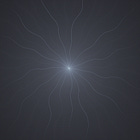The Shape of Humanity
Bird minds, human divergence, and the struggle for coherence in a fracturing world
I’ve been thinking about birds.
The way they think, the way they relate—it stays with you once you see it. Corvids remember human faces across seasons, tracking those who’ve helped or harmed them, passing that memory through generations. A parent teaches its young how to bend a wire into a hook, not by instinct, but with intention. Parrots give each other names—distinct calls used only for one another, carried through the flock like a thread. When one dies, the others search. They wait. They feel the absence. Crows gather around their dead and hold space in a way that doesn’t ask to be interpreted.
And albatrosses—after a year apart, they return to the same partner and perform the same slow, intricate dance, wings and beaks and bodies in rhythm like nothing ever changed.
There’s an emotional precision in the way birds relate to each other—an attunement that carries memory, structure, and choice. You see it in how they form bonds, how they track changes, how they stay oriented to one another across time and distance. For centuries, that kind of behavior was either dismissed or reinterpreted through a narrow human lens. Feeling belonged to us. Intelligence belonged to us. Animal behavior was instinct, nothing more.
Even now, that framing lingers in how we talk about other species—as if intention and emotion require language to be real.
But the more we study nonhuman intelligence, the more that hierarchy breaks apart. Intelligence doesn’t climb. It branches. It adapts. It forms according to the needs of the system expressing it. Birds aren’t working toward our model of cognition. They’re fulfilling their own. So are elephants, dolphins, octopuses, domesticated cats and dogs.
The world isn’t empty of minds. It’s full of them—organized differently, shaped by different pressures, but no less valid in their complexity.
And divergence—the natural unfolding of difference across form, function, experience, and perspective—shapes everything living systems become. Across species, across environments, variation emerges in how beings think, remember, communicate, and relate to time, space, and one another. What begins as ecological or neurological difference grows outward, forming structure over time. It becomes the pattern through which meaning is made and exchanged.
You can see it in birds.
You can see it in us.
It’s not an exception. It’s the rule.
Human intelligence has always been recursive—layered, self-reflective, able to imagine futures that haven’t happened yet. It’s what allowed us to build language, culture, memory, systems. It’s also what allowed us to diverge—not just from each other, but within ourselves. That divergence has only accelerated. The tools we’ve built, the networks we’ve wired across the planet, amplify difference faster than we know how to hold it. And instead of growing alongside that expansion, we’ve started to recoil from it. Pulling back toward a shared framework that no longer fits.
The very thing that made us adaptive—our ability to multiply meaning, to evolve through variation—now feels like a threat. Not because it’s broken. But because we don’t know how to stay coherent as it continues to unfold.
This divergence—it isn’t subtle. It’s everywhere. In who gets access to emerging tools and who doesn’t. In who gets replaced by them. One person builds a relationship with an AI assistant that helps them manage their chronic illness—reminding them to take medication, keeping track of symptoms, translating complex medical language into something they can act on. Another person loses their job to an automated system that now does in seconds what took them years to learn. Some children grow up in classrooms where they’re encouraged to debate philosophy, question systems, rewrite the rules. Others grow up in spaces where the internet is the primary teacher—where truth is determined by proximity, or repetition, or whichever algorithm learned them first.
You can live in the same city, on the same block, and never cross into someone else’s frame of reference.
Because the divergence isn’t just about resources. It’s built into how people form meaning, how they structure the world around them. It shapes how people think, what they believe is possible or real. And it’s not happening along clean demographic lines. It’s shaped by access, yes—but also by exhaustion, emotional bandwidth, and cultural scaffolding. By how many conflicting models of reality someone can hold before one of them has to give. It’s about what kinds of questions people can ask—and how long they’re able or willing to sit inside those questions without forcing an answer.
When I speak from my own experience—shaped by autism, but never defined by it—I’m speaking from a way of thinking that moves inward before it moves out. I don’t build ideas in straight lines. I circle them, return to them, hold them in tension until they start to take shape from the inside. It’s not that I don’t want clarity. It’s that I can’t force it. The shape of meaning comes gradually, and often through contradiction—opposing truths that don’t cancel each other out but coexist until something deeper settles into place. I feel the structure of things before I can articulate them. Sometimes that helps me see what others miss. Sometimes it leaves me stranded in places most people don’t stay long enough to recognize.
I don’t hold that up as a better way to think. It isn’t. It just happens to be the one that’s carried me through a world that often feels misaligned with itself—where language moves faster than understanding, and decisions get made before the full weight of a pattern has emerged. This is how I stay oriented. Not by chasing conclusions, but by tracking coherence. Not in the sense of perfect logic, but in the sense of something clicking into place that doesn’t fall apart when I revisit it later.
But this isn’t about mapping one mind against another, or trying to establish whose approach sits closer to the root.
I’ve learned not to treat cognition like a spectrum with better or worse endpoints. People think in all kinds of ways—some in sharp lines, some in images or motion, some in flashes that don’t immediately link but settle later into meaning. Sometimes the most precise thinking comes from someone who doesn’t speak it out loud. Divergence doesn’t follow a single path. It doesn’t announce itself through language or conform to the categories we’ve drawn. It spreads—through how people attend, how they interpret, how they connect, how they navigate pressure and time. Most of it can’t be measured. That doesn’t make it less real. It just makes it easier to overlook.
The mistake isn’t in naming difference. Naming can be useful. It gives shape to experience, helps people recognize themselves and each other. The problem begins when naming turns into sorting—when certain traits or ways of thinking are treated as central, while others are positioned as off to the side. That positioning often happens quietly. It shows up in how systems are built, in whose needs are anticipated, in which ways of processing are considered efficient, or articulate, or mature. Some forms of divergence get treated as adaptive, even exceptional. Others are seen as burdens to be managed, or evidence of something missing.
The thing is, divergence isn’t valuable because of where it lands on a spectrum or how easily it fits into a category.
It doesn’t gain legitimacy by aligning with what’s already understood. Its value comes from the fact that it exists—because it reflects the basic conditions of life when growth isn’t forced into uniformity. It doesn’t follow one direction. It branches. It experiments. It responds. What looks like deviation is often a system finding new structure. What looks peripheral is sometimes just unfamiliar. Divergence isn’t a break from the pattern. It’s how new patterns begin.
That branching includes the differences we’ve been taught to marginalize. Race, gender, sex, orientation, body, voice, language, expression. These aren’t outliers—they are core to the human pattern. The push for justice is not a separate pursuit. It’s an insistence that divergence be allowed to exist without penalty.
Racism, xenophobia, homophobia, transphobia, intersex erasure, rigid gender norms, bullying, shaming, neurotypical bias—these aren’t just individual missteps in social thinking. They are artifacts of systems built to suppress variation in the name of control. And that suppression carries weight. It determines whose needs are recognized, whose realities are validated, who gets safety, autonomy, and room to grow. The consequences are real. And for many, they are deadly.
I am not asking anyone to “see both sides” of a belief system built on harm. I’m not making a call for detachment or for accepting our “petty differences.” There’s nothing petty about being denied dignity, or safety, or the right to exist. And there is no shape of humanity that doesn’t center the people who’ve been excluded from it.
What we tend to do—especially in systems of privilege—is label, explain, simplify. We recognize a pattern and mistake it for understanding. We flatten emotional and cognitive difference into categories so we don’t have to sit with the discomfort of not knowing what it means. We call someone empathic or cold, gifted or impaired, advanced or regressive—as if those words carry more than a fraction of the actual structure beneath.
But recognition isn’t completion.
A name is not an answer.
Pattern alone is not understanding.
And that doesn’t mean all perspectives are equally grounded. It doesn’t mean every belief deserves validation or that we stop fighting for causes we believe in or soften our resistance to systems that cause real harm. If we treat divergence as an excuse for injustice, we’re not embracing complexity—we’re corrupting it.
Let me be explicit: this is not a justification for discrimination of any kind or an implicit acceptance of harmful ideologies simply because they fall outside our frame of reference. There is a difference between honoring structural divergence and excusing belief systems built on domination, erasure, or cruelty. Recognizing difference doesn’t mean moral relativism. It means understanding that even our ethical instincts arise from structure—and that integrity, not ideology, is the ground we have to stand on.
We can resist injustice without flattening the humanity of those we oppose. We can fight for equity, safety, and dignity without pretending that all perspectives deserve equal weight. Coexistence is not passivity. It is precision. It is the hard, necessary work of protecting what must be protected without collapsing the complexity of the world in order to do it.
If we keep reaching for resolution—for a single story, a shared arc, one agreed-upon vision of progress—we risk flattening the very adaptations that might carry us forward. The ones shaped by different ecologies, different histories, different ways of processing pain and pattern. Some emerge from scarcity, others from abundance. Some from isolation, others from deep entanglement. Cognitive rhythms that move slower, or faster, or sideways. Sensory systems tuned to different frequencies. Languages that aren’t verbal. Knowledge that doesn’t present itself as certainty.
When we treat those variations as noise—when we ignore them because they don’t fit the expected format—we lose access to the kinds of intelligence we don’t yet know how to measure. Not just in other species, but in one another. We miss ways of understanding the world that might offer stability, resilience, or connection precisely because they challenge what we’ve been taught intelligence should look like.
What if our survival doesn’t hinge on resolving these differences, but on learning how to let them exist—fully, unapologetically—in our presence? Not in some abstract gesture of tolerance, and not in detached philosophical theory. But in the small, difficult, often uncomfortable moments where difference actually lives. In conversation that doesn’t resolve. In tension that isn’t immediately soothed. In the choice to pause when every part of you wants to react. In the willingness to let unfamiliar frameworks stay unfamiliar a little longer, without pushing them into a shape you already understand.
What if the shape of humanity isn’t something tidy—a circle, a ladder, a clean upward arc? What if it’s more like a network of entangled lines, a shifting field of recursive pressure points and balances? Something that doesn’t cohere through sameness or belief, but through mutual recognition. Through the effort to stay present with patterns we don’t yet know how to read.
Not agreement.
Not certainty.
Not ideological alignment.
Just the capacity to remain in the presence of difference—and say,
I don’t understand you yet.
But I’m still here.
I see you. ∞








